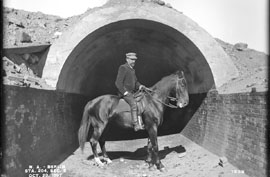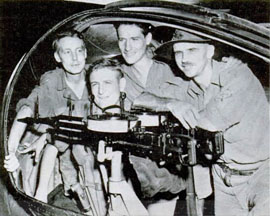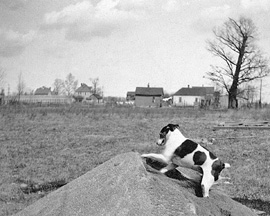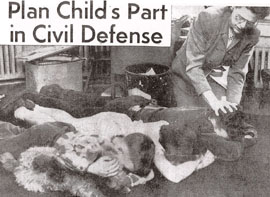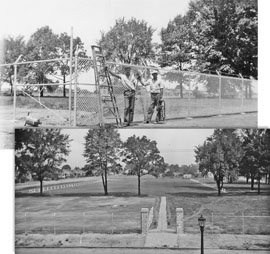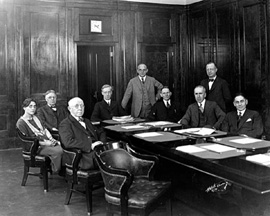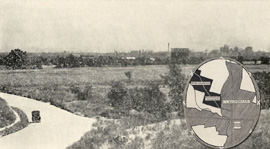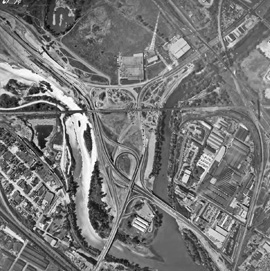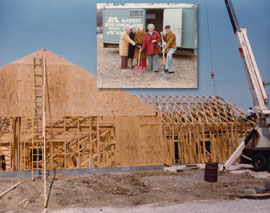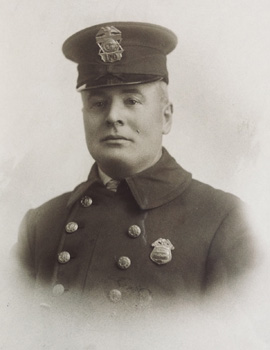February 23, 2011 will mark the 75th anniversary of the disappearance of 24-year-old Lola Celli. She was a 5'4" teacher from Logan County who spoke 5 languages, and was visiting her parents in Grandview. She was going shopping in downtown Columbus for nylons and some fabric for her mother that fateful morning. She was last seen leaving her parents' home on 3rd Avenue, walking the several blocks towards the bus stop at Cambridge and 3rd Avenues. She never boarded the bus.
A massive search in eight states turned up no clues. Locally over 150 high school boys from Grandview and Upper Arlington were recruited to search along the Scioto River and in the quarries. This newspaper photo is of Grandview High School boys walking down Grandview Avenue to search for Lola (inset).
The day she disappeared one witness riding a motorcycle reported seeing someone who looked like her in a car on Olentangy River Road arguing with a man. During the spat a red shoe was either thrown or dropped from the window. Lola was wearing red suede shoes that day. No shoe was ever found on that stretch of road and the case remains open with Lola officially listed as missing. Grandview Police Chief Robert Livingston issued this short report:
"At the suggestion of Chief of Police, Village of Marble Cliff, Ohio, GV reporting officer organized a search of area from Grandview Avenue north to Trabue Pike, along the Scioto River, and bordered on the north and east by the Pennsylvania Railroad. This search was conducted by the Ohio State Highway Patrol, Franklin County Sheriff's Office, Upper Arlington Police Department, Grandview Heights Police Department, and approximately 150 Upper Arlington and Grandview High School students.This search was conducted with negative results. This search was conducted and concluded on March 1, 1946."
In the months and years following her disappearance numerous reports on this mystery were filed. In most cases they were about alleged sightings and evidences that first inflamed and then put off the hopes of family members and acquaintances that still held out hope that she would be found safe.
Sylvio Casparis, an Italian immigrant that settled in Columbus in 1888, established and developed several stone quarries west of the city near what is now Marble Cliff. He had a large home designed by Frank Packard that is now the 10 Arlington Place. Called by locals the "Casparis Castle", it included a tower that overlooked his quarries so that he could watch the operation from his home.
Sylvio Antonio Casparis was born in Italy in 1850. He came to the United States when he was 7 years old, and made his way to Columbus in 1888 and established the Casparis Stone Company. He worked as a contractor for many years, including building roads and dams and using crushed stone to develop railroad beds.
This 1897 photo shows Casparis astride a horse during construction of the Nashua (later renamed Wachusett) Aqueduct (photo courtesy Massachusetts State Archives), which serves the Boston water supply. Casparis was hired to do extensive masonry construction at the Wachusett Reservoir project. That same year he joined fellow contractor and business owner W.O. Taylor as VP of the Columbus Macadam Company, and later as co-owner of the Casparis Marble Company in North Carolina.
The Columbus Macadam Company used crushed stone from the quarry to pave many main roads throughout the region. The Casparis Stone Company worked the quarries along the Scioto, one of which was the Casparis Quarry, established in 1891, and in 1913 he merged with the Woodruff-Pausch Stone Co. to start Marble Cliff Quarries Company.
His mansion, which he reportedly called Elton House, was built in Marble Cliff in 1908. Designed by famed architect Frank Packard to mimic a Scottish castle, it came to be known as "Casparis Castle". It is now 10 Arlington Place in Marble Cliff. Casparis died in December of 1921.
Dale Bordner served as mayor of Grandview Heights from 1971 to 1974. He is shown here at the left with his crew mates in the gun blister of an Australian seaplane that rescued them after their WWII B-26 bomber was shot down. The B-26 was often referred to as the "widowmaker" because of the number of crashes that the aircraft was involved in.
At dawn on May 24, 1942, a B-26 Marauder aircraft with a crew of eight took off from New Guinea on a bombing mission against a Japanese airfield at Rabaul. The radioman on this mission was Cpl. Dale E. Bordner from Grandview Heights.
After successfully dropping their payload of 100 pound bombs, destroying many Japanese planes, the bomber, nicknamed the Imogene VII, was hit by anti-aircraft fire and ditched in the ocean just off shore from a Japanese occupied island. Two crewmen died in the crash, and one died of injuries later. After being rescued by local natives, two others were turned over to the enemy. Bordner, who suffered life-threatening injuries, and the other two survivors hid on the atoll for 10 months before being rescued by an Australian RAAF Catalina seaplane.
This photo, from a LIFE Magazine article (June 28, 1943) documenting their ordeal, shows Bordner at the left, his other two crew mates, and an Australian who helped with the rescue, inside of the seaplane gun blister.
Bordner received a Purple Heart, the Silver Star, and the Soldiers Medal. He returned to Ohio and served as Grandview Heights City Council President and was elected Mayor in 1971. He was one of the founders of the Grandview Boys Athletic Association and was it's President. In 1974, after a bitter fight to remain Mayor, the courts ruled that his job with the Ohio Water Development Authority was public employment, and thus violated Grandview's charter that prohibits city officials from holding other public jobs. He stepped down and was replaced as Mayor by Larry Pierce. Bordner, who lived on Palmer Road, died from kidney failure in 1981.
Affectionately known as "old figgers junior, the walking encyclopedia of insurance statistics and facts", in his profile in the book Club Men of Columbus, Grandview resident Claude Seibert was the founder of Fifth Avenue Floral Co. The company greenhouses on West Fifth Avenue are shown at the left in this photo.
The location of this dog playing on a sand pile was erroneously identified in the Grandview Heights/Marble Cliff Historical Society archival database as being the current site of Trinity Methodist Church at the southwest corner of Cambridge Blvd. and Fifth Avenue. After research analysis of the photograph, it was determined to be a view looking southeast towards Arlington Avenue from the future site of Roxbury Road just north of Fifth Avenue in Upper Arlington.
The greenhouse, houses, and barns (left in the image) line Fifth Avenue. The large three-story Victorian foursquare house to the right of the greenhouse is the home at 1564 Arlington Avenue, which was built in 1903. There is evidence to suggest that the greenhouse was part of the Fifth Avenue Floral Company, founded in 1901 and one of the most successful and longstanding florist businesses in Columbus.
An early president of the floral company was Grandview resident Claude Seibert, a colorful entrepreneur and local personality whose home was at 1101 Broadview. (Incorporation records show that the company was incorporated in 1905, with Martha Seibert as a partner.) He served as Mayor of Grandview Heights from 1915 until 1919, and enjoyed a long and illustrious career in the insurance industry. He was depicted as a cashier with the John Hancock insurance agency in his 1911 caricature from the book Club Men of Columbus, and at the height of his career he was second vice president of the National Life Insurance Company.
The florist's greenhouses and a retail shop were recorded to be on Fifth Avenue and the original retail shop was at 120 East Broad Street and is now located at Kenny and Kinnear near the OSU west campus. By 1923 the company was selling $100,000 worth of flowers and shrubs per year.
During the Cold War period, fear of a nuclear attack by the Soviet Union was widespread. In 1951, the Federal Civil Defense Administration (FCDA) hired a New York City ad agency to create a film that could be shown in schools to educate children about how to protect themselves in the case of an attack.The resulting film, titled Duck And Cover, depicted safety techniques in preparation for the dangers from such attacks. The film (photo inset) instructs students to "make like Bert the turtle: duck under tables or desks, or next to walls, and tightly cover the back of their necks and their faces". In the film Bert is shown dropping to the ground ("DUCK!") and retreating into his shell ("COVER!") after an explosion.
This photograph is one of several from the March 4, 1951 Sunday Columbus Dispatch which illustrated different precautions for protecting children from potential atomic bomb attacks. Grandview resident, Mrs. Edward Fries of 1204 Lincoln Road, is shown illustrating one of "six survival secrets for atomic bombs" also published in the Ohio Civil Defense Bulletin. She is demonstrating on her own children, Eddie, Bobby, and Susan, and their pet dog Lixie. Upon seeing a bomb flash children were trained to run inside the nearest building, duck, and cover their heads.
The Duck and Cover drills, which were part of President Harry S. Truman's FCDA program, were aimed to educate the public about what ordinary people could do to protect themselves and they became standard school drills. They were expanded to be applied in other situations where structural destabilization or flying debris might be expected, such as during an earthquake or tornado.
Started during the Great Depression, the federal WPA (Works Progress Administration) provided funds for construction, renovation and other projects across the United States until the postwar boom in 1943. In Grandview Heights the WPA was responsible for constructing, renovating and maintaining city school district buildings and grounds, as well as several other projects in the community.
For example, WPA funds were used to construct the tennis courts and a ticket building/concession stand at the athletic fields just to the north of the high school in 1936. The program also earmarked $28,000 for the construction of a new stadium on the athletic field on the condition that the district would contribute an additional $3,000 towards the construction effort. School officials turned to the community, and a successful fund-raising effort guaranteed the down payment. However, as construction was scheduled to begin, officials in Washington sent a letter requiring an increased payment.
Dedicated to the success of this effort, the "stadium boosters" fundraising effort continued, and the 1250 seat stadium was completed and dedicated on October 7, 1938. The Bobcats easily defeated Westerville 25-7 in the inaugural game that night. Representatives from schools throughout the state came to tour the stadium facility during the dedication, which was seen as one of the finest combination facilities of its size around.
The top photo shows WPA workers doing site preparation by erecting a barbed wire chain link fence. They are standing at the northwest corner of Fairview and Third Avenues. The bottom photo shows the athletic field just prior to construction of the stadium.
Grandview resident Julius F. Stone was appointed to the Ohio State University Board of Trustees in 1909 and served until 1917. He continued to be involved with the Board as Treasurer, and in 1925 was reappointed as Trustee to fill the unexpired term of Charles F. Kettering until 1930. He was again reappointed in 1930 and served until 1937.
Stone was a prominent Columbus industrialist and served as President of several large companies, and was Chairman of the Board of Seagrave Corporation, manufacturer of fire-fighting equipment He was also quite prominent in philanthropic activities, including donating liberally himself. For example, in 1925 Stone purchased Gibraltar Island, once the summer home of Jay Cooke. Cooke was an American financier who helped finance the Union war effort during the Civil War and the postwar development of railroads in the northwestern United States. He is generally acknowledged as the first major investment banker in the United States. Stone immediately signed over the deed and donated the island to Ohio State University for Lake Erie research. The laboratory is called the Franz Theodore Stone Laboratory in honor of Julius Stone's father.
In 1924, Ohio State appointed Alma Wacker Paterson as the first woman to serve on the Board, and she served until 1933. She succeeded Thomas Mendenhall after his death in 1924. Mendenhall was appointed in 1873 as the first faculty member at Ohio State, and served on the Board for only four years and nine months before Paterson's appointment by the governor, A. Victor Donahey. He had already indicated that the next appointment to the board would be a woman since "the large number of women registered at the University warrants the selection," according to an OSU Lantern article. OSU's Paterson Hall is named for Alma Paterson, who had previously been assistant director of physical education for women at Ohio State. She was recently featured by the University Archives during Women's History Month.
This photo shows the Ohio State Board in 1926. Stone is at the front left, and Alma Paterson is behind him. Other members of the Board at the time were Herbert Atkinson, Egbert Mack, John Kaiser, Lawrence Laybourne, and Harry Caton,. Carl Steeb was the Board Secretary.
(Photo courtesy of The Ohio State University Archives)
During World War I, a food crisis emerged in Europe as agricultural workers were recruited into military service and farms became battlefields. The opportunity to feed millions of people overseas was taken up by the United States. In early 1917, the National War Garden Commission was organized to encourage Americans to contribute to the war effort by planting, fertilizing, harvesting and storing their own fruits and vegetables so that more food could be exported to Europe. Citizens were urged to utilize school and company grounds, parks, backyards or any available vacant lots for gardens.
Promoted through "Sow the Seeds of Victory" propaganda posters the war garden movement was spread by numerous women's clubs, civic associations and chambers of commerce. Amateur gardeners were provided with government instruction pamphlets on how, when and where to sow, and were offered suggestions as to the best crops to plant, along with tips on preventing disease and insect infestations. In addition, the federal Bureau of Education initiated a U.S. School Garden Army to mobilize children to enlist as "soldiers of the soil." By the end of World War I, the campaign promoting home gardens (Victory Gardens) had dropped off, but many people continued to maintain them.
Shortly after the U.S. entered World War II, victory gardens began to reemerge. With the introduction of food rationing in the United States in the spring of 1942, Americans had an even greater incentive to grow their own fruits and vegetables. Throughout both world wars, the Victory Garden campaign served as a successful means of boosting morale, expressing patriotism, safeguarding against food shortages, and easing the burden on the commercial farmers working to feed troops and civilians overseas. In 1942, roughly 15 million families planted victory gardens. by 1944, more than 40 percent of all the fresh fruits and vegetables consumed in the United States were grown in victory gardens.
This photo is from 1918 and shows two women consuming the "fruits" of their labors. The inset is from a 1942 Mechanix Illustrated magazine instructing readers how to best plan their V-Garden, Victory Garden. Grandview had a community garden on Goodale Boulevard, and it was moved to the corner of Grandview Avenue and Goodale and named Wallace Gardens. A community kitchen existed during World War I on First Avenue in which the vegetables from the community garden were prepared into community meals. When World War II ended, so did the government promotion of victory gardens. Many people did not plant a garden in the spring of 1946, but agriculture had not yet geared up to full production for grocery stores, so the country experienced some food shortages.
In 1916, brothers King and Ben Thompson, who were eventually responsible for the early planning of what would become Upper Arlington, established the Northwest Boulevard Company to realize a dream of developing the community, which they envisioned to be similar to one they had visited in Kansas City. The plan of development was to be executed on the Miller Farm north of Fifth Avenue due to the land's location, attractiveness, and environment. The Miller Farm was close to Columbus' city center ("within three and one-half miles, in a straight line, from the business center of Columbus"), and was on high ground — an aspect especially important in the context of the Ohio Flood of 1913. The city streetcar service, then just reaching the southern end of the planned development, and other public services were also considered. They realized they needed an artery from downtown to the northwest side in order to enhance the accessibility of their new development by automobile, and Northwest Boulevard was envisioned. The brothers purchased land through their development company that would allow them to build the thoroughfare.
The plats of their Northwest Boulevard subdivision were filed in 1916 and 1917, and included properties carved out of the 345 acre Thomas farm in Grandview. The new subdivision comprised a significant portion of what is now Grandview Heights east of Grandview Avenue, between Goodale and Third. The road, Northwest Boulevard, would be designed to traverse their subdivision and enter the heart of their new planned community.
This photograph, captioned "The Skyline of Good Old Columbus Town, Taken from the Knolls of The Northwest Boulevard" appeared on the inside cover of the October 1918 Norwester magazine. It was part of an advertisement for residential lots for sale by the Thompson's company. Ben was president of the company and King was secretary. One major role of the company (besides developing the subdivision and the Thomas farm) was to be a liaison with the Franklin County Commissioners. The advertisement boasted that, "as the crow flies, the Ohio Statehouse was less than two miles away from the development".
The online website roadfan.com documents roads and highways and focuses on road construction projects across the United States. One project that is extensively discussed is the Spring-Sandusky interchange project that connects Spring and Sandusky Streets, Route 33, and State Route 315.
This aerial photograph is taken above the confluence to the Scioto and Olentangy Rivers, looking west toward Grandview Heights. The WBNS-10TV studio is shown with the original broadcast tower to its left in the top center of the image. To the left of that is the old Coca-Cola bottling plant near the site of the current main post office, with Twin Rivers Drive curving just below it.
In the center of the photo is the Spring-Sandusky interchange, connecting Spring and Sandusky Streets, Route 33, and State Route 315. Spring Street runs from the bottom right to the top left, where it connects with Rt. 33. Sandusky Street was the connection between Twin Rivers and Franklinton, and was built over by the section of 315 at the lower left that runs south to the I-70/I-71 interchange.
The original interchange project was proposed in 1952, begun in 1954, and was completed at a cost of $8.3M in 1958. However, as a result of the 1956 National Interstate and Defense Highways Act, the road and the interchange required modifications almost immediately after it was completed. The estimate for the number of cars handled in this interchange was woefully inaccurate, and it became quite congested as a result. In 1965 a new connection for I-70 west (present day I-670 from Hague Ave to I-71) was proposed in order to reduce traffic on the "spaghetti" interchange.
Planning for this part of the freeway was completed in 1971, and it was originally intended to be called I-70, with I-70 and I-71 overlapping through downtown. In 1976 it was re-designated as I-670 as part of a new master plan for a Columbus innerbelt connecting I-70 at Hague and I-270 at the airport. Financial shortfalls, environmental concerns, and neighborhood objections resulted in a dead-end at Grandview Avenue. Additional environmental legislation, including a moratorium on re-routing the Scioto River, delayed the continuation of the freeway even more. Funding from taxes related to new shopping malls in Columbus solved some of the financial shortfalls, the environmental issues were resolved, and it was finally completed in 2003.
After meeting for seven years in the old fellowship hall of Boulevard Presbyterian Church, the Cliff Heights Seniors moved in to their new home at 1515 W. Goodale Boulevard. The new building, designed by architects Abbot and Abbot, was officially opened for business on October 16, 1982 and was then called the Grandview Heights Senior Center. Their regular monthly potluck was held before the October 16th dedication ceremony for the Seniors only, and had almost a full house. The building, shown here as construction began, is owned by the city of Grandview Heights, who agreed to operate the facility for twenty years as a Senior Center (the inset shows five Grandview seniors participating in the groundbreaking for the facility.)
The city received a HUD Grant for $150,000 for community development. With funding from the State of Ohio, the Village of Marble Cliff, the city of Grandview, Northwest Kiwanis, Cliff Heights Senior Club and other private funds, the city of Grandview paid a little over $360,000 for the building. The offices for the Parks and Recreation administration are located on the east end of the building and the adjacency has been a big asset to the Seniors for the nearly 40 years that the Center has been in operation. The building is now under the management of Parks and Recreation, and continues to operate not just for Seniors but for the entire community, offering programs for all ages that speaks to the health, recreation and general welfare of the citizens of Grandview Heights and the surrounding communities.
The Maypole dance is a form of folk dance that originated in Germany, and in England and Sweden at about the same time. The most popular version of the dance consists of between 8 and 16 girls (the traditional dance alternates girls and boys around a circle) that perform circle dances around a tall, sometimes garland-festooned pole. (The record for the largest maypole dance consists of 163 couples, or 326 participants, doing a seven step dance around a 40 foot pole.)
These 1918 photographs are from the Historical Society's Alleyne Higgs collection. It shows a group of Grandview girls participating in the Maypole dance. Each dancer holds a different colored ribbon and moves in a circle around the pole. As they do so, the dancers intertwine their ribbons either in a web around the pole or to plait it to the pole itself. The pattern on the pole is determined by the choreography of the dance.
In a simple form, every other girl goes the opposite direction and alternates moving in front or behind the girls coming the other direction (see the inset of the photo), weaving the ribbons around the pole. A challenge for the dancers is to retrace their steps exactly in order to unwind the ribbons.
Some historians believe the first Maypole dance originated as part of Germanic pagan rituals. However, the more common belief is that maypoles were erected "simply" as "signs that the happy season of warmth and comfort had returned." Originally, the dancers danced around a living tree.
While dancers usually perform this dance in the spring on May 1 or May Day, those in Sweden perform it during their midsummer celebrations. The celebration has become common throughout Europe and in the U. S. and has seeped into popular culture. For example, a scene in Frozen shows the Maypole being erected as Elsa's coronation is beginning, and it has appeared in several Mad Men television episodes.
This editorial cartoon appeared in the Columbus newspaper in early 1923. It was referring to an argument between Columbus and Grandview firefighters related to the jurisdiction of each fire unit. A home on West Fifth Avenue suffered extensive fire damage while the two fire crews argued over who was responsible for putting the fire out.
The April 4, 1923 issue of the weekly magazine Fire and Water Engineering (V73, #14) had a short paragraph discussing the conflict between Grandview and Columbus related to the purview of their respective fire departments.This conflict began in 1922 when the City of Columbus, who had been providing fire service to the community, began charging Grandview for any fire service runs. The period leading up to this point was a time of tremendous growth in the Grandview and Marble Cliff area. Homes were being built in the community at a rapid rate, and Columbus saw the number of fire runs increasing. They maintained that they couldn't continue to service Grandview at no charge.
According to the magazine, as a result of a fire which destroyed a building in February of 1923, Grandview presented a bill to Columbus for the water which the Columbus firemen used in extinguishing the flames. That was the outcome of the controversy between Columbus and Grandview over the matter of fire protection. In March of 1923 the two municipalities attempted to get together in a contract which would give Grandview the benefit of the firefighting apparatus of Columbus, but Grandview refused to pay the price of $1 on each $1,000 on the village tax duplicate. The Columbus safety director informed Grandview that they would have to use their own apparatus in putting out any fires within the Grandview or Marble Cliff limits, and that Columbus firemen would not be permitted to cross the corporation line under any circumstances.
Grandview responded with a statement that the use of any Grandview water to put out fires in the section of Columbus lying in the Columbus "finger" between Third and King Avenues, would be charged for. The February bill for the water used was the consequence of this decision. Columbus somewhat relented, and the safety director determined that a response from Columbus Fire could occur with a request for aid from the Grandview Mayor, a Council Member, or the City Clerk.
The conflict took a nasty turn later in April. A fire, at the home of Leonard Thomas at 1847 West Fifth (in the disputed "finger") resulted in Columbus responding to the fire. Columbus Battalion Chief Charles Barklow subsequently received what the newspaper called "a wetting" from the Grandview firefighters. When Grandview insisted they could fight their own fires, the Columbus team was ordered by Barklow to leave the emergency and return to their station. It was then that the Grandview firemen turned their hoses on the Columbus crew. Mayor Ryder from Grandview had to apologize to Columbus Safety Director McCune. These disputes resulted in Grandview establishing a fully independent fire department, and they built the existing fire station on Grandview Avenue.
The week following the "wetting", the above editorial cartoon appeared in the newspaper.
William Walter Reed was born in 1876 in Franklin County, the seventh of eleven sons of Robert and Mary Elizabeth Reed. In his early youth he worked as a farmhand (on a farm on the site of the current Scioto Country Club) before joining the Jeffrey Mining Company around 1900.
After several years, he and three partners purchased the Pinhook Saloon at the corner of Fifth and Gerard (near where the Five Guys restaurant currently is located). The Pinhook Saloon was one of several notoriously rowdy bars on West Fifth, frequented by circus personnel from the Sells Circus which wintered in Sellsville near there. Reed and his partners converted the bar into a bowling alley, pool hall, and grocery store.
In 1914 Reed partnered with Upper Arlington founder King Thompson's brother in law Hobert Herrick to open a grocery store at Fifth and Wyandotte. Reed would visit each house in northwest Grandview and the 150 or so houses in Upper Arlington, taking grocery orders which he would then fill and deliver.
Because of his familiarity with the residents, he was appointed Constable of Franklin Township in 1919. He worked as a new car salesman for the Carroll-Thomson Ford dealership on Long Street during the day, and some of the UA residents would each pay him $5 a month to patrol the area at night.
In 1920, Reed was appointed Deputy Marshal in Grandview, working for Marshal Clarence Salzgaber, and the next year became Grandview's first Chief of Police. Reed was on the Grandview police force until his death in 1943, and was succeeded by Chief Robert Livingston.
Reed and his wife Jessie and three children (Hazel, Norman, and Cecil) lived at 1307 Elmwood in Grandview. His great-grandson Steve Wilson recently donated his police badges and some of his memorabilia to the Historical Society.

